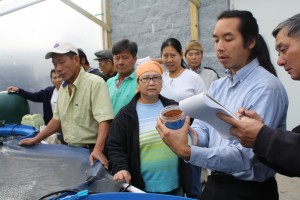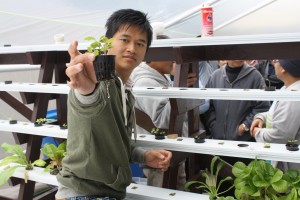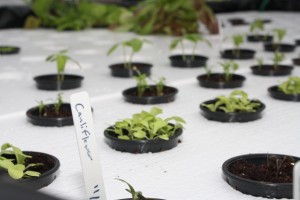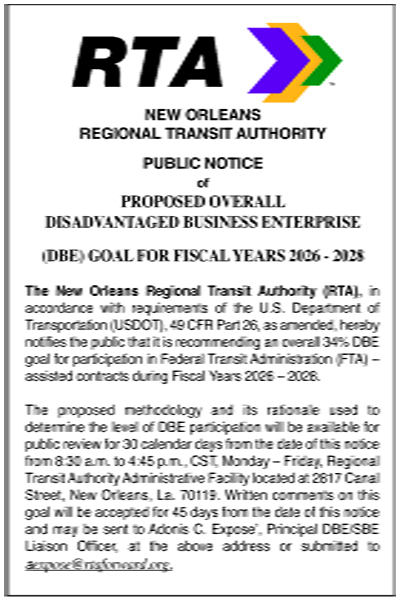Aquaponics being taught in Vietnamese community
19th December 2011 · 0 Comments
By L. Kasimu Harris
The Louisiana Weekly
The students’ aim is turning brown poop into green money. So far, they have spent three days in a classroom studying the theory and application of their endeavor: Aquaponics.

Daniel Nguyen explains the aquaponics process to members of the Vietnamese community.
Photos by David T. Baker
It’s a process of combining farming fish that help grow plants, which results in two sellable products.
Monday afternoon at the MQVN, Community Development Corporation, Inc in eastern New Orleans, 11 students sat at tables with steno notebooks, pens and a bottle of water in front of them. The instructor, speaking in Vietnamese, pointed to a board and explained the process with words and pictures.
The fish are fed grain pellets and produce excrement. The waste flows into a tank with bacteria that converts it into nitrites. Then, ammonia transforms nitrites into nitrates and flows through the PVC pipes into the water. Now, the nutrient rich water flows to the plants where their roots are submerged.
“Once you get started, all you have to do is feed the fish,” Tuan Nguyen, deputy director of MQVN, said.
The project began in November 2010, and was originally only about fishing. MQVN held a community meeting, and over 100 people attended. Then, John Hopkins University got involved and conducted a marketing study. While doing fieldwork, a local supplier introduced MQVN to the concept of aquaculture, farming fish in controlled environments. The last component was Oxfam, an international organization that works with communities to improve lives, and contributed a $55,000 grant. 
There is an application process, but no one is turned away. MQVN is a not-for-profit organization located in the commercial shopping area dubbed “Viet Village” on Alcee Fortier Blvd. and Chef Menteur Hwy. that worked with Job 1 and Delgado Community College to offer the non-credited course. Established in 2006, MQVN provides education, health care, social services, among other things, to the residents of the mostly Vietnamese Village de l’Est neighborhood. Some of the students were impacted by the BP oil spill (Deepwater Horizon) in April 2010.
“This is way that they can get a new livelihood,” said Daniel Nguyen, workforce development and environmental justice coordinator for MQVN. “It’s not something foreign to them, [fishing and farming] but it is still cutting-edge enough to be new.”
Students exited the building’s side entrance and walked into the greenhouse, a 13-by-40 structure constructed with PVC pipe and clear tarp—it smells like tap water from a hosepipe on a summer day.
The class chatted and then rapidly asked the instructor questions. Tuan Nguyen translated the comments: “They are questioning the greenhouse,” he said. “Agriculture is a tradition in our culture, but the greenhouse is a new concept.” The students wanted to know if the greenhouse would be too hot, because the temperature was colder outside.”
To their right was the air system connected to the three large blue tanks filled with water and fish. The first tank was Koi; the second was Channel Catfish and the third Blue Gill. The fish were purchased as fingerlings, about two to four inches in length and in three weeks are four to six inches. Daniel Nguyen said in warmer weather their metabolism increases and the fish grow faster.
The students learned two different types aquaponics, NFT and Raft. The NFT is water flows through gutters on top of wooden shelves and the plants are placed in the holes in the gutter and roots extend like straws directly into the water.
The raft method floats Styrofoam on the water and the plants’ roots also go into the water. Various plants — Kale, Thai Eggplant, tomato and cauliflower — have begun to sprout in three weeks.
On Tuesday, Daniel Nguyen showed the class how to mix in the ammonia and test the nitrate levels in the water. 
“It’s very hard at first,” Kha Nguyen said, “but we continue to learn and it will be easier in the future.”
Kha Nguyen, 62, was a shrimp trawler, until the oil spill and then a boating accident in May 2010 kept him docked and unable to make money during the clean-up process. Kha Nguyen’s father trawled in Vietnam. Kha Nguyen walked into the greenhouse with his son, Qouc Nguyen, 33, a third-generation trawler. Both father and son said they needed a change and wanted to learn more about aquaponics and hope to run a farm in the future.
Phu Nguyen, 61, wrote notes in a steno notebook, labeled the steps with roman numerals and drew a diagraph of the aquaponic process. “This may possibly better the livelihood of my family in the future,” Nguyen, a mechanic, said. Phu Nguyen added that their community suffers from a lot of contaminants and it’s important for them to utilize more organic processes like aquaponics.◊
MQVN, whose motto is “Return, Rebuild, Reclaim,” has enough money to fund at least six start-ups greenhouses, which cost a few thousand dollars. Their goal is to secure additional funding. “Sometimes, you have to do it first and then ask for money,” Tuan Nguyen said.
The staff at MQVN consists of several young people that don’t consider themselves handy. Conversely, several members of the class are sustenance farmers and said farming fish would be as easy as a hobby.
“We figured if we didn’t know what the hell we were doing,” Tuan Nguyen said, “then they could do it.”
This article originally published in the December 19, 2011 print edition of The Louisiana Weekly newspaper.
Tags: aquaculture, aquaponics, farm, fish, Mary Queen of Vietnam, MQVN, Nguyen, nitrate, nitrite, Oxfam, styrofoam, Vietnamese, village de l'est



